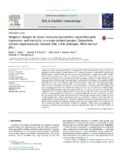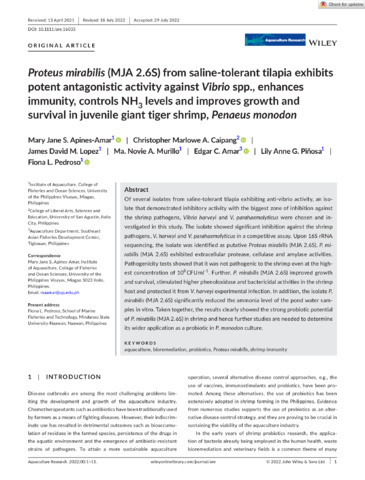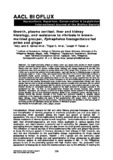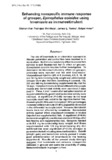Temporal changes in innate immunity parameters, epinecidin gene expression, and mortality in orange-spotted grouper, Epinephelus coioides experimentally infected with a fish pathogen, Vibrio harveyi JML1
Share
စိတ္တဇ
Changes in innate immunity parameters and epinecidin mRNA transcript levels were examined to characterize the non-specific immune response of E. coioides to pathogenic V. harveyi JML1 isolated from affected cage-cultured fish. After fish had been injected with bacteria at a dose causing 30% mortality, blood and tissue samples were collected at 0, 6, 12, 24, 48, 72, 96, 120, and 240 h post-infection (hpi) for assessment of indices such as the oxidative burst (OB) and phagocytic index (PI) of head kidney cells, and lysozyme activity (LYS) and total immunoglobulin (Total Ig) levels of the plasma. The epinecidin mRNA transcript levels (EGE) from skin, gills, liver, kidney, and spleen tissues were also determined by gelbased RT-PCR. Lastly, daily mortality (DM), liver total bacterial load (TBC), and presumptive Vibrio count (TVC) were monitored up to 240 hpi. The results revealed that bacteria proliferated rapidly in fish tissue, reaching peak densities at 24 hpi for both TBC and TVC but was on a downward trend thereafter. The pattern in fish mortality closely correlated with TBC and TVC. Total Ig, OB, and PI in E. coioides were suppressed in the early part of infection when V. harveyi load was high but recovered and later increased as bacterial density declined. LYS and EGE were consistently high and their activities were not hampered by bacterial infection. The study demonstrated that V. harveyi JML1 interacts with E. coioides by transiently inhibiting some immune parameters resulting in mortalities. However, consistently high LYS, upregulated EGE, and resurgent PI, OB and Total Ig conferred resistance and subsequent recovery in the fish. The study provides new insights on the interaction between E. coioides and V. harveyi JML1 that can aid in formulating health management strategies for groupers. Further studies on prophylactic interventions to enhance the innate immune response in grouper during infection with V. harveyi JML1 are suggested.
Keywords
Immune response Host-pathogen interaction Epinephelus coioides Vibrio harveyi Epinecidin gene expressionSuggested Citation
Amar, E. C., Faisan, J. P., Jr., Apines-Amar, M. J. S., & Pakingking, R. V., Jr. (2017). Temporal changes in innate immunity parameters, epinecidin gene expression, and mortality in orange-spotted grouper, Epinephelus coioides experimentally infected with a fish pathogen, Vibrio harveyi JML1. Fish and Shellfish Immunology , 69, 153-163. https://doi.org/10.1016/j.fsi.2017.08.005
ဘာသာရပ်
Taxonomic term
စုစည်းမှုများ စုစည်းမှုများ
- AQD Journal Articles [1249]
Related items
Showing items related by title, author, creator and subject.
-
Proteus mirabilis (MJA 2.6S) from saline-tolerant tilapia exhibits potent antagonistic activity against Vibrio spp., enhances immunity, controls \(\mathsf{NH_3}\) levels and improves growth and survival in juvenile giant tiger shrimp, Penaeus monodon
Apines-Amar, Mary Jane; Caipang, Christopher Marlowe; Lopez, James David M.; Murillo, Ma. Novie A.; Amar, Edgar; Piñosa, Lily Anne G.; Pedroso, Fiona (Wiley, 2022-08-10)Of several isolates from saline-tolerant tilapia exhibiting anti-vibrio activity, an isolate that demonstrated inhibitory activity with the biggest zone of inhibition against the shrimp pathogens, Vibrio harveyi and V. ... -
Growth, plasma cortisol, liver and kidney histology, and resistance to vibriosis in brown-marbled grouper, Epinephelus fuscoguttatus fed onion and ginger
Apines-Amar, Mary Jane S.; Amar, Edgar C.; Faisan, Joseph P., Jr. (Bioflux, 2013)The health-promoting effects of dietary onion and ginger were studied in brown marbled grouper, Epinephelus fuscoguttatus. An eight-week feeding trial was conducted to evaluate the effects of dietary onion and ginger on ... -
Enhancing nonspecific immune response of grouper, Epinephelus coioides using levamizole as immunostimulant
Pedrajas-Mendoza, Sharon Ann; Torres, James L.; Amar, Edgar (University of the Philippines in the Visayas, 2008)The use of levamisole as an alternative approach to disease prevention and control has been resorted to in aquaculture. Its immunomodulatory effect in several fish species is well documented but its effect on grouper, ...




